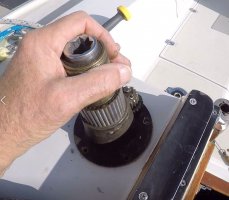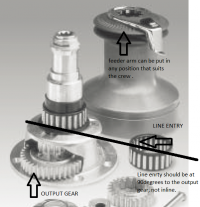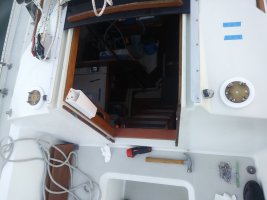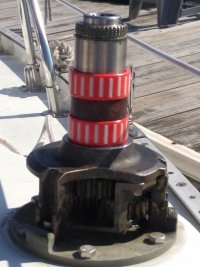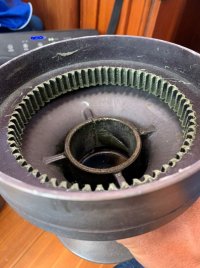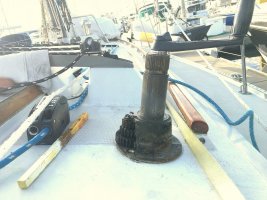I installed a new Lewmar 30ST winch without regard to orientation, and Loren caught the error in my blog entry.
So let's think it through. Do I need still need help situating the winch? Apparently so.
Winches need to be installed so the correct gear takes the load from the handle. Incorrect orientation makes them wear out faster. I received no install document with the winch. Loren provided this Lewmar diagram (I never could find it on the Internet):
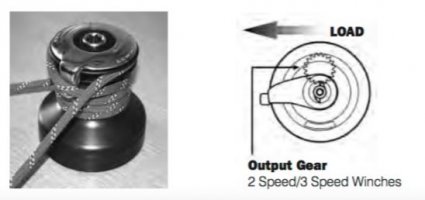
Simple enough. Now, is the "Output Gear" on the new winch "A" or "B"?
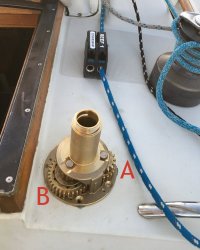
(Orientation as shown is incorrect.)
The Lewmar diagram seems to show a fairly small gear intersecting the spindle as the "output gear."
Meantime, a Harken install document shows their "Drive Gear" further outboard.
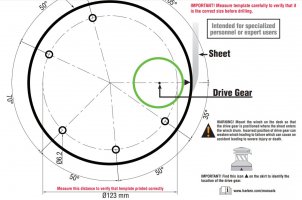
Let's see what Anderson winches has to say:
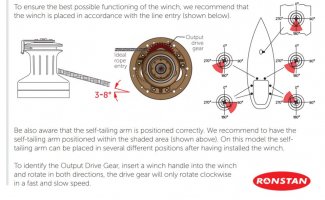
Anderson/Ronstan identifies the largest gear as the "Output or drive gear."
Their document also tells how to locate it: "To identify the Output Drive Gear, insert a winch handle into the winch and rotate in both directions. The Drive Gear will only rotate clockwise in a fast and slow speed."
Ah, progress! Except...when you perform that test on the Lewmar, it is the largest gear ("Large Gear" in photo) that reveals itself as the all-important Output Gear on which proper orientation depends.
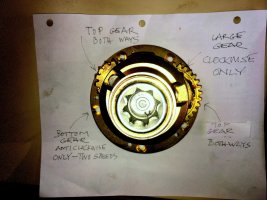 ...
...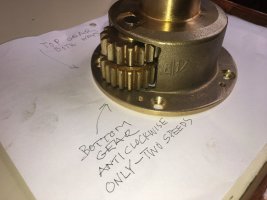 ...
...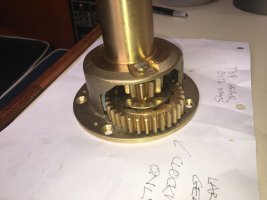
And that gear resembles not at all the Output Gear in the Lewmar diagram (first photo in this post).
I'm awaiting clarification from Lewmar. I sent them the "A" and "B" photo asking which one is the Output Gear.
But perhaps one of us can identify an "output gear" by rational analysis of the mechanics. Alas, the gear interactions of a 2-speed winch are 2 speeds beyond me--and others on the Internet equally confused bout Lewmar winch orientation.
So let's think it through. Do I need still need help situating the winch? Apparently so.
Winches need to be installed so the correct gear takes the load from the handle. Incorrect orientation makes them wear out faster. I received no install document with the winch. Loren provided this Lewmar diagram (I never could find it on the Internet):

Simple enough. Now, is the "Output Gear" on the new winch "A" or "B"?

(Orientation as shown is incorrect.)
The Lewmar diagram seems to show a fairly small gear intersecting the spindle as the "output gear."
Meantime, a Harken install document shows their "Drive Gear" further outboard.

Let's see what Anderson winches has to say:

Anderson/Ronstan identifies the largest gear as the "Output or drive gear."
Their document also tells how to locate it: "To identify the Output Drive Gear, insert a winch handle into the winch and rotate in both directions. The Drive Gear will only rotate clockwise in a fast and slow speed."
Ah, progress! Except...when you perform that test on the Lewmar, it is the largest gear ("Large Gear" in photo) that reveals itself as the all-important Output Gear on which proper orientation depends.
 ...
... ...
...
And that gear resembles not at all the Output Gear in the Lewmar diagram (first photo in this post).
I'm awaiting clarification from Lewmar. I sent them the "A" and "B" photo asking which one is the Output Gear.
But perhaps one of us can identify an "output gear" by rational analysis of the mechanics. Alas, the gear interactions of a 2-speed winch are 2 speeds beyond me--and others on the Internet equally confused bout Lewmar winch orientation.
Last edited:

